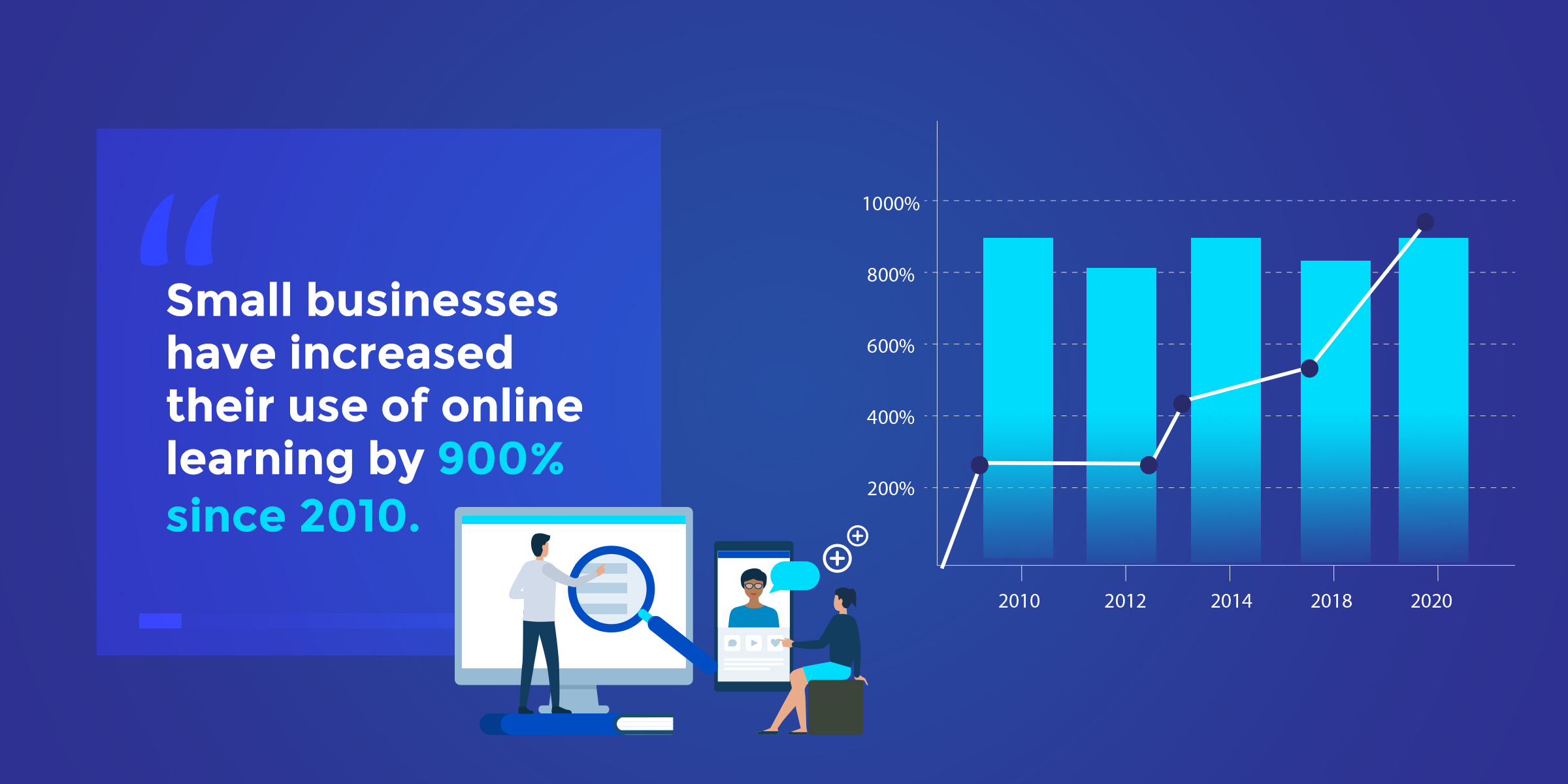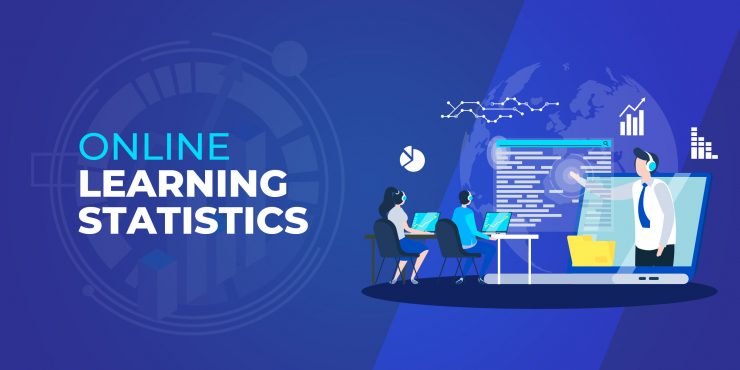You may not realize it, but online education is one of the fastest-growing industries in the world.
COVID-19 has affected almost every aspect of our lives, including schools and colleges. Teachers and administrators have had to switch to digital classrooms, placing an emphasis on online learning more generally.
With that being said, taking classes online or completing electronic degrees is not a new phenomenon. Students have been doing so to bolster their education for years, with many learning platforms not officially being associated with any specific university.
Need an expert quote for your story? We’re happy to help. Contact our Founder, Geoff Cudd.
Corporations and other businesses are also using online courses to train their workforce. Because online training is known to increase overall efficiency and productivity, it’s become an integral part of many business models over the years. Even government institutions have taken up digital learning to increase their staff’s efficiency.
On top of all of that, many savvy entrepreneurs, marketers, and publishers are looking at online learning as a new, lucrative profit center. Selling online courses is a very attractive business opportunity due to recurring, passive revenue.
The best part about online learning is that anyone with a working electronic device and an internet connection can generally take part in classes, or create their own courses to make money.
Here are our 56 statistics about online learning that we think our readers should know. We’ll be exploring its growth, use in professional and academic contexts, and its burgeoning future.
We offer this website completely free to our visitors. To help pay the bills, we’ll often (but not always) set up affiliate relationships with the top providers after selecting our favorites. However, we do our best not to let this impact our choices. There are plenty of high-paying companies we’ve turned down because we didn’t like their product.
An added benefit of our relationships is that we always try to negotiate exclusive discounts for our visitors.
Key online learning statistics
Before we get into specifics about how online learning has become so profitable, it’s important to understand the scope of the industry itself. In this section, we’ll take a look at some large figures associated with online learning and the effect that it’s having on economies and people around the world.
- The eLearning industry has grown by 900% since 2000
- More than 40% of all Fortune 500 companies are using online learning for training.


- Online learning reduces energy consumption by 90% and slashes CO2 by more than 85%.
- The U.S. accounted for over 31% of mobile learning expenditures in the global market.
- The US government spent more than $11 billion on self-paced eLearning products for its staff and administrators.
- North America, primarily the United States, was responsible for over 35% of global eLearning revenue in 2020.
- The user penetration rate in the Online Education market is projected to be 17.8% in 2024.
- Video web activity accounts for over 80% of all online activity, with many of these videos being educational or training clips.
- Online teachers earn approximately $46,590 a year on average.
Online learning growth statistics
One of the most remarkable things about online learning is how much it’s grown over the past few decades. Concurrent with greater accessibility to computers and the rise of the internet, the online learning industry has grown exponentially, and will likely continue to do so. One of the biggest areas of growth is the online course creation and distribution sphere, which has seen a surge in revenue over the past few years. Here are some statistics that put online learning’s growth into perspective.
- The online learning industry has grown by 900% since the turn of the century.


- The number of registered learners on Coursera has increased by 438% in 5 years.
- The European eLearning market is expected to grow by $147.7 billion between 2021 and 2025.
- Revenue generated by course sales on Thinkific is projected to surpass $1.5 billion by 2021.
- Online college enrollment in bachelor’s degrees grew for the first time in several years (+1.2%), but this incremental growth was driven by community colleges (+2.6%) and privates (+1.0%).
- Small businesses have increased their use of online learning by 900% since 2010.
- Germany’s online learning market is growing at a rate of 8.5% annually.
Businesses using online learning
Given its increasing accessibility, many corporations and enterprises are beginning to leverage online learning to train their employees. Various studies have been conducted over the years looking at how online training has affected overall productivity, as more and more businesses are looking toward this option to increase their bottom line. Here are some important online learning statistics for businesses.
- 80% of businesses now offer online learning/training solutions
- Brandon Hall Group’s research found that online training courses can cut down training time as much as 60%.
- Online training can also boost overall knowledge retention by 25% to 60%.


- Online training allows for “microlearning,” or learning pieces about their jobs in smaller doses instead of a long dedicated training session. This can account for 218% higher revenue for employees under this training framework.
- For every $1500 an employer spends on training for each worker, they can improve improvements in their profit margins of about 24%.
- Investing an additional $680 results in a shareholder return of 6%.
- For every dollar spent on online training, the employer makes back $30 in productivity.
- More than 67% of organizations around the world claim to support mobile learning of some sort.
Schools using online learning
The first thing that probably comes to everyone’s mind when they hear “online learning” is online schools. We’ve seen many online universities pop up over the years, and many schools and universities are beginning to switch to online classrooms given the current pandemic. However, focusing on those two elements would severely limit the scope of online learning in an academic setting. Using digital learning platforms to bolster your education or to complete your degree can be done in many different ways. This section focuses on the ways in which students of all ages are taking advantage of online academic courses.
- 70% of students say online learning is better than traditional classroom learning
- 75% of schools in the US plan to operate completely online.
- The percentage of graduate students who completed their degrees online increased from 6.1% in 2008 to 27.3% in 2016.
- Eight Ivy League schools have adopted online courses, albeit with caution and in conjunction with in-person classes.
- Online colleges and universities enroll nearly 2.79 million students, accounting for 15% of all U.S. postsecondary learners
- The global MOOC (Massive Open Online Courses) market is expected to grow by 29% between 2020 and 2025.
- The MOOC market could reach $21.4 billion by 2025, despite being valued at $5.16 billion in 2019.
- The UK Department of Education found that about 79% of MOOC users have bachelor’s degrees and 44% have postgraduate degrees.
Top online course platform statistics
With countless institutions trying to use online learning as cheaper alternatives for their bottom line or professional degrees, we’ve seen the demand for course content creators rise over the past few years. Consequently, MOOC sites and online course hosting platforms have proliferated as a response to this need. We’re seeing millions of teachers, trainers, and other professionals leveraging these sites to build their own curriculums and sell them to users looking to complete their degrees or add another skill to their resumes.
Marketing professionals and publishers are beginning to see these platforms as legitimate revenue sources, and are using sites such as Udemy to offer free and paid lessons. This is evident in the popularity of marketing classes across both MOOC sites and independent online course platforms. However, we’re still seeing users take a variety of online courses through these platforms, including food, exercise, and self-habits. Let’s look at some statistics for the most popular online learning platforms.
- Edx is one of the most popular MOOC sites and has over 6,100 courses from over 230 accredited institutions.
- Hubspot Academy, a MOOC training platform for marketing and sales management, has grown to a user of over 165,000 professionals since 2012.
- Udemy currently offers over 24,000 business, tech, and software courses for users at an average cost of about $15.
- Saylor similarly offers over 100 courses with partnerships with various educational institutions for individuals looking to complete their degrees.
- IngramSpark offers free online learning courses on publishing that can be completed in 1 hour on average.
- Digital Publishing 101 offers over 100 free online lessons on publishing.
- Kajabi is one of the most popular online course platforms that’s served over 85 million users worldwide in over 120 countries.
- Their course creation features have generated over $1.5 billion in sales.
- Thinkific is a popular online course hosting platform that allows users to craft their own courses and has over 50,000 users of its own.
- Thinkific’s user base spans over 190 countries and has hosted over 75 million total courses since its inception.
- Over 100 employees currently work for Thinkific across 15 different countries.
- Thinkific has generated over $15 million in revenue in 2023 from its course creation and hosting services.
- Teachable has served over 100,000 instructors on their course creation platform since 2013.
- Teachable’s most popular course is a language course.
- The top 3 types of independent online courses on Teachable are language courses, Excel, and watercolor painting.
- Teachable has generated over $150 million in revenue as an online course creation hosting platform.
Also Read: Steps to take when your course has been pirated
Future of online learning
Even without the current pandemic, the future of the online learning industry would still be looking at an upwards trajectory. With COVID-19, however, that upwards trend is magnified, as more and more people will look towards online learning platforms as a means of learning new skills and selling their own coursework to others. That comes with certain considerations about improving online learning, both in terms of accessibility and technical support.
- Corporate eLearning is expected to grow by 250% by 2026
- Global E-Learning Market to Reach $325 billion by 2025.


- Mobile learning is expected to grow to $38 billion.
- While 51% cite poor user experience and 44% the cost of LMS technology as the big barrier.
- The number of online learning users is expected to increase to 57 million by 2027.
- 52% report that the inability of LMS platforms to integrate with other digital systems is a barrier to satisfaction.
- 24% are not satisfied with LMS platforms that have limited or no mobile capabilities at all.
- 66% of LMS users want providers to improve their customer and technical support.
Leveraging online learning statistics
Over the past few months, we’ve seen COVID-19 change our lives right before our very eyes. Workers, coaches, and students around the world are relying on telework and digital classrooms, increasing the demand for online learning. However, given the industry’s growth over the past decade, it’s safe to say that more innovations are likely on the horizon when it comes to digital learning and its capabilities.
Students can still complete their degrees, and workers can obtain new skills through instructional classes. Employers can increase their bottom line by using online courses to train their employees, while professionals and instructors can lend their expertise by creating their own curriculums. As the world struggles to return to in-person classrooms, online learning provides an avenue for individuals to continue learning and developing their skills.
Sources:
- https://www.luisazhou.com/blog/elearning-statistics/
- https://www.forbes.com/sites/forbestechcouncil/2018/07/25/the-next-revolution-in-global-elearning/#794a66bd7c25
- https://www.strategyr.com/market-report-e-learning-forecasts-global-industry-analysts-inc.asp
- https://eclass.teicrete.gr/modules/document/file.php/TP271/Additional%20material/docebo-elearning-trends-report-2017.pdf
- https://www.luisazhou.com/blog/elearning-statistics/
- https://www.luisazhou.com/blog/elearning-statistics/
- https://www.statista.com/outlook/dmo/eservices/online-education/united-states
- https://www.webmarketingpros.com/internet-video-to-account-for-80-of-global-traffic-by-2019/
- https://www.ziprecruiter.com/Salaries/Online-Teacher-Salary
- http://www.brandonhall.com/blogs/brandon-hall-group-research-published-june-5-june-11/
- https://explodingtopics.com/blog/elearning-statistics
- https://analysis.technavio.com/e-learning-industry-analysis-research
- https://www.businesswire.com/news/home/20200929005148/en/Thinkific-Raises-22M-to-Meet-Surging-Demand-in-Online-Courses
- https://www.ruffalonl.com/blog/graduate-online-enrollment/5-graduate-and-online-enrollment-trends-to-watch-in-2024/
- https://smallbiztrends.com/2017/12/2018-e-learning-trends.html
- https://www.learning-insights.de/en/2018/06/07/dienstleister-im-deutschen-e-learning-markt-verzeichnen-weiter-hohes-umsatzwachstum/
- https://www.devlinpeck.com/content/online-learning-statistics
- http://www.brandonhall.com/blogs/brandon-hall-group-research-published-june-5-june-11/
- http://www.brandonhall.com/blogs/brandon-hall-group-research-published-june-5-june-11/
- https://www.forbes.com/sites/ryanrobinson/2019/05/03/leaders-workplace-create-time-deep-learning/#4c8e3ba1b462
- https://www.statista.com/statistics/548191/mooc-student-awareness-worldwide/
- https://www.statista.com/statistics/548191/mooc-student-awareness-worldwide/
- http://www.brandonhall.com/blogs/brandon-hall-group-research-published-june-5-june-11/
- https://www.strategyr.com/market-report-e-learning-forecasts-global-industry-analysts-inc.asp
- https://www.statista.com/statistics/548112/online-course-student-access-worldwide/
- https://www.devlinpeck.com/content/online-learning-statistics
- https://www.luisazhou.com/blog/elearning-statistics/
- https://thebestschools.org/magazine/ivy-league-online-college/
- https://www.forbes.com/advisor/education/student-resources/online-learning-stats/
- https://www.mordorintelligence.com/industry-reports/massive-open-online-course-mooc-market
- https://www.mordorintelligence.com/industry-reports/massive-open-online-course-mooc-market
- https://assets.publishing.service.gov.uk/government/uploads/system/uploads/attachment_data/file/807625/DFR_Online_learning_and_AIEd_market_review.pdf
- https://missiongraduatenm.org/edx-reviews/
- https://academy.hubspot.com/?hubs_signup-url=academy.hubspot.com%2Fcourses&hubs_signup-cta=logo-utility-nav
- https://www.google.com/aclk?sa=l&ai=DChcSEwi_-LnY5ZSEAxUsSH8AHTOPC9UYABAAGgJvYQ&ase=2&gclid=CjwKCAiAq4KuBhA6EiwArMAw1C0gBLOHYlmEcH1ywNrAwwfVDuZrENIqckWwwXbadbwenzv1pAcyIxoCbAMQAvD_BwE&sig=AOD64_2m0PyZspu2VnqOqWkTcluNbOjyyA&q&nis=4&adurl&ved=2ahUKEwi30bHY5ZSEAxVUl2oFHdAcAGEQ0Qx6BAgIEAE
- https://kajabi.com/about-us
- https://www.ingramspark.com/self-publishing-courses
- https://digitalpublishing101.com/
- https://www.prnewswire.com/news-releases/kajabi-creators-set-new-gmv-record-by-earning-over-6-billion-in-revenue-as-the-platform-sets-its-sight-on-9-billion-in-2024-301951844.html
- https://kajabi.com/about-us
- https://www.thinkific.com/
- https://www.thinkific.com/
- https://www.thinkific.com/about/
- https://www.thinkific.com/
- https://teachable.com/about
- https://nutmegeducation.com/teachable-course-examples
- https://nutmegeducation.com/teachable-course-examples
- https://teachable.com/about
- https://www.luisazhou.com/blog/elearning-statistics/
- https://www.forbes.com/sites/tjmccue/2018/07/31/e-learning-climbing-to-325-billion-by-2025-uf-canvas-absorb-schoology-moodle/#7d1fe5463b39
- https://kometa.edu.pl/uploads/publication/634/550a_A_Docebo-E-Learning-Trends-2019.pdf?v2.8
- https://kometa.edu.pl/uploads/publication/634/550a_A_Docebo-E-Learning-Trends-2019.pdf?v2.8
- https://www.devlinpeck.com/content/online-learning-statistics
- https://kometa.edu.pl/uploads/publication/634/550a_A_Docebo-E-Learning-Trends-2019.pdf?v2.8
- https://kometa.edu.pl/uploads/publication/634/550a_A_Docebo-E-Learning-Trends-2019.pdf?v2.8
- https://kometa.edu.pl/uploads/publication/634/550a_A_Docebo-E-Learning-Trends-2019.pdf?v2.8





















